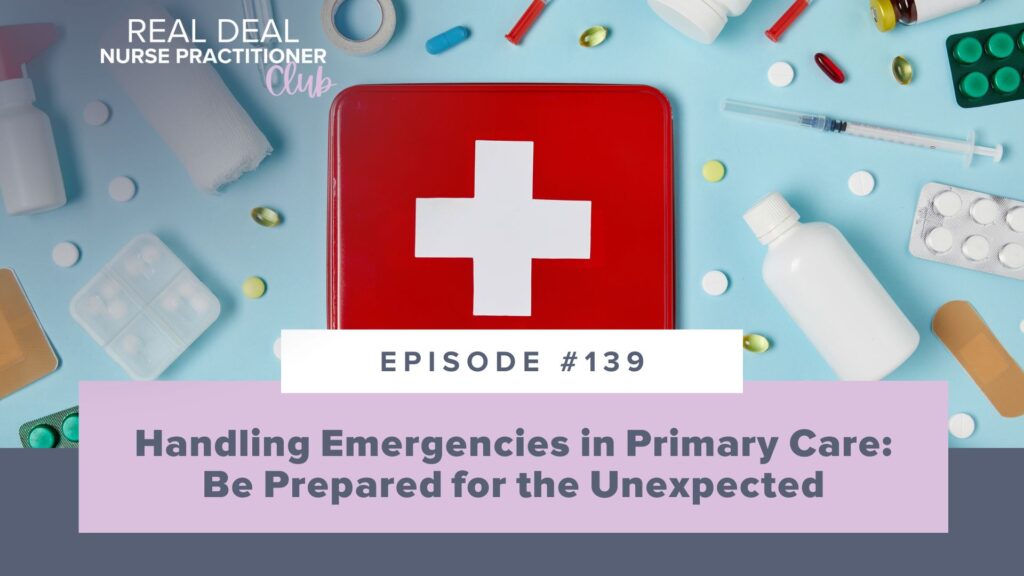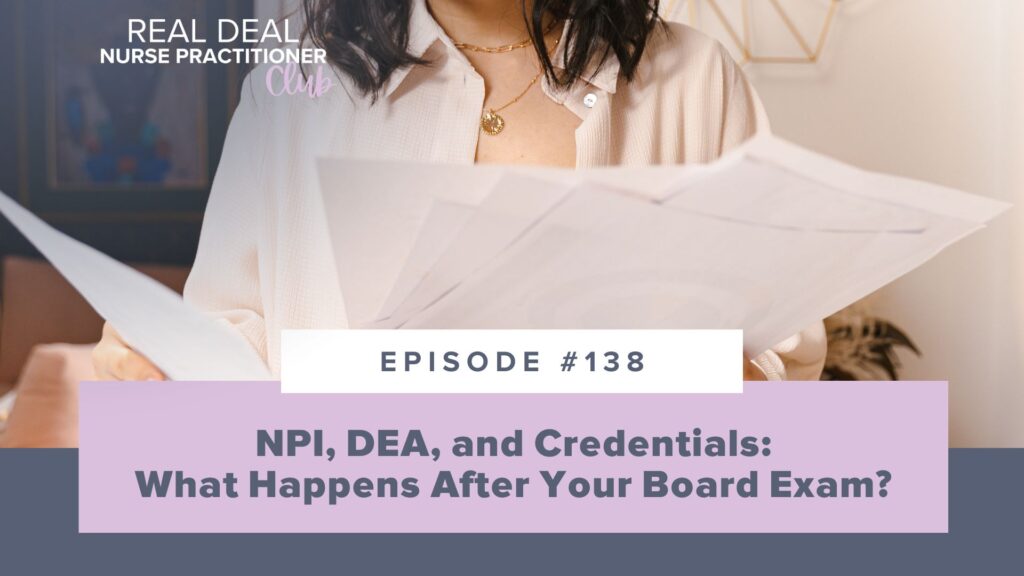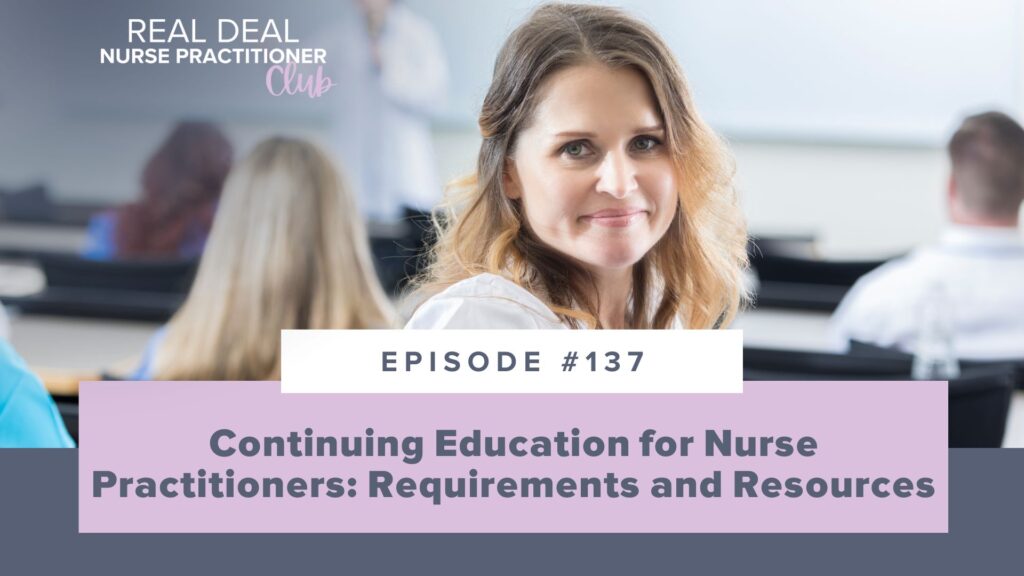
We had a great response to our asthma episode so I thought I’d do another guideline update today, and this one is all about pap smear tests. As was the case in the last episode, we’re reporting on the changes for your reference as a Nurse Practitioner, and this shouldn’t be construed as medical advice.
This gets complicated because we have three places that put out guidelines on paps. We’re casting some light on the grey areas of pap smears so you’re prepared for any related questions that might come up on your Nurse Practitioner journey.
Tune in this week to hear about all the recent changes in pap smear test guidelines. I’m discussing the history of paps, why it’s unusual that two out of three authoritative bodies have changed their guidelines while the third has remained the same, and I’m sharing some important best practices around pap tests.
If you’re looking for support, no matter what phase of your nurse practitioner journey you’re currently in, I have communities available for both students and new nurse practitioners. In these communities, we work to uplift one another and grow this profession together every day, so click here to check them out!
What You Will Discover:
- Why two out of three authorities on pap smear tests changing their guidelines creates a grey area.
- A history of pap smears, why we do them, and some best practices surrounding them.
- The changes we’re seeing to guidelines around pap test best practices and how to apply them to your work as a Nurse Practitioner.
Featured on the Show:
- If you’re looking for extra support, I have communities available for both students and new nurse practitioners. Click here if you’re a student, and click here if you’re a new NP!
- Ep #82: GINA Asthma Guideline Updates
Full Episode Transcript:
Welcome to Becoming a Stress-Free Nurse Practitioner, a show for new NPs and students that want to pass their board exam the first time and make that transition from RN to NP as seamless as possible. I’m your host Sarah Michelle. Now, let’s dive into today’s episode.
Hello, my friends, Sarah Michelle here. We had such a great response to the asthma update episode, that I thought I would do another guideline update today. However, this episode comes with the same caveat that we are just here reporting the guidelines to you today and what has changed. But none of this should be taken or misconstrued as medical advice. We’re literally just reporting it to you and you can do what you want with it.
So, the changes we’re going to be talking about today are to the Pap smear guidelines. And this gets a little confusing because we have three places that put out guidelines on Paps. Those three places are the American Cancer Society, ACOG, also known as the American College of Obstetrics and Gynecology. And then the third one is going to be the USPSTF, what a mouthful, right? And that is the United States Preventive Services Task Force.
So the place I want to start today before we get into a little bit of history about Paps, is about which guidelines have changed because two of them have not, only one has. And the one that has changed is the American Cancer Society.
And interestingly enough, ACOG has not changed their guidelines, and instead has come out and solidified their guideline stance, even in light of these changes. And the USPSTF, they have not changed guidelines, but they have not put out any further statements either. So they’re kind of the in between.
It’s very rare that we see these authoritative bodies at odds over guidelines, usually we’re all on the same page. But just know for your exams, if you’re a student listening to us, that the American Cancer Society guidelines have historically been the ones that have been followed. And your exam never wants to put you in the gray area, it will be very clear with the answer choices.
Now for practice, we’ve got these three bodies, two of which are saying one thing, one of which is saying something new. And it is a little bit of a gray area right now. And so usually we only have one body or two bodies that are telling us the guidelines. And I always say go with what’s evidence based, go with what’s the latest and the greatest, but this is going to be a decision that you have to make on your own. And it’s something that you want to do with all the information possible, so that’s what we’re going to be covering in this episode today.
But before we can really dive into these changes, I just want to take a step back in history for a little bit and tell you about Pap smears, why we do them, and kind of the best practice surrounding them. So we’re going to take a step way back here in time to the late 1800s where George Papanicolaou, who was a pioneer in reproduction and reproductive research, invented the Papanicolaou or Pap test or smear.
Now, if you can believe this or not, his research actually began in Guinea pigs where he figured out that the menstrual cycle could be tracked via vaginal secretions. And then in 1943 he collaborated with Dr. Herbert Traut, who is another noteworthy gynecologic pathologist. And together they published something called the diagnosis of uterine cancer by the vaginal smear.
And this was really the first outline of its kind that related changes in vaginal secretions and hormones to malignancy. Although Papanicolaou was not the first to identify cancer as cellular changes under the microscope, he was really the first to put his findings out there, which is why he is regarded as the inventor or founder of the Pap smear.
Now, the early work of Aurel A. Babes, who was a Romanian pathologist, actually preceded Papanicolaou’s work in showing those early microscopic changes to the cervix that can predict malignancy. However, the English speaking world definitely latched onto Papanicolaou’s work, which is obvious because we call it the Pap smear, right?
So the first real study involving Pap smears was a bit, well, not as robust as the studies that we see today. There was no formal IRB process, but instead Dr. Traut and another gynecologist, Dr. Marchetti, used patients admitted to obstetrics and gynecology at New York Hospital as study participants.
Vaginal secretions were obtained from all these patients, which showed, in many cases, the early cytologic signs of malignancy. This was the landmark study used in diagnosis of uterine cancer by the vaginal smear, which is what I mentioned earlier.
But vaginal secretions were not showing to be specific enough to detect true cervical cancer or pre-cancer. And so in comes another doctor, we’ve talked about so many at this point, Dr. J. Earnest Ayre, who went one step further and developed the scrape biopsy that is now the standard of care when doing Pap smears.
This outlined the best technique and tool, or that spatula, to be used to obtain the smear. And this is the craziest part, these things have not really changed since he first outlined this in the early 1900s. That is how spot-on his testing and his techniques were and still are.
Now, obviously microscopes used to detect cellular changes have improved in the last 100 years, but the general process has not. It really has stood the test of time, which I think is pretty impressive.
So even though the technique, tools, and benefits of Pap smears had been developed, the implementation of routine screening was another base in and of itself. And if you have ever worked in a setting where change is being implemented, no matter how big or small, you can understand how slow introducing an entirely new screening test to millions of patients would be.
So the routine Pap smear was not recommended or even done until the 1970s and even into the 1980s. And nowadays, obviously, we know the benefits of early detection and treatment of cervical cancer. But back then it was not clear the implications of routine testing, which was why it was so hard to get clinicians to adopt this recommended practice.
The American Cancer Society did not even have an official Pap smear guideline until 1980, which does not even seem like that long ago if you think about it. The first guideline was for yearly Paps for those over age 20, and under aged 20 if they were already sexually active. And then after two negative tests, at least a year apart, the patients could then opt into every three year testing. And this really kind of remained the status quo from the American Cancer Society until 2012.
2012 was like yesterday, y’all. And this is when the American Cancer Society was seeing all of this new data from that new HPV vaccine, because the HPV vaccine was eliminating, or beginning to eliminate, high-risk subtypes of HPV. And we know those high-risk subtypes cause upwards of 90% of cervical cancer.
And so that is when the guideline changed to 21 to 29 year olds every three years. And those over 30 every five years as long as an HPV co-test was added. I do want to mention as well that this is when ACOG was also following these guidelines and they were all one and the same.
So now let’s talk about the actual changes by first talking just a little bit more about the old guidelines because that’s what ACOG still recommends. ACOG has actually not even reviewed updating, per their website publications, since 2021, so definitely something to watch.
But anyways, these old guidelines are Pap smears starting at age 21 with no HPV co-testing unless abnormal results are found, like those atypical squamous cells of undetermined significance. And from age 21 to 29, it is recommended that Paps are done every three years.
And then after age 30 we see the HPV co-testing added with routine Paps every five years if normal or Paps alone every three years, and only HPV testing added again if something abnormal pops up.
The new American Cancer Society guidelines don’t start Paps until 25, which is in response to the effectiveness of the HPV vaccine, which is pretty cool and pretty awesome reasoning for a guideline change.
So basically the HPV vaccine, and remember HPV is the cause overwhelmingly of cervical cancer, is so effective that the incidence of cervical cancer has taken a nosedive. From 2012 to 2019 alone the incidence of cervical cancer in patients under the age of 24 declined by 65%. And that was already after a 33% decline from 2005 to 2012. That is huge.
I mean, that is a decline rate that is so rare to see with any kind of cancer. And so the American Cancer Society looked at all this new data and saw that cervical cancer rates had declined so much in the under 25 population, that they changed the recommendation to begin Pap smears at age 25 instead of 21.
And at age 25, their highest recommendation was to add on HPV testing automatically to the Pap, and if all was normal, not repeat for five years. They do note that every three years doing a Pap alone is still acceptable, however. And the over 30 guidelines did not change much as the American Cancer Society, like ACOG, still recommends that Pap of HPV co-testing every five years, or less highly recommended the Pap by itself.
Now, I mentioned earlier about the USPSTF, or that United States Preventive Services Task Force. And like we also mentioned, they haven’t updated their guidelines yet. They still have the same recommendations as ACOG.
All bodies do not recommend Paps over age 65, which is an interesting recommendation, as we know with the aging general population, and those over 65 account for over 20% of cervical cancer patients currently. So this is a guideline that we might see changed in the future.
In practice, it would be a really great idea to check individual insurance coverage in these patients and see if insurances are covering perhaps over age 65. If they’re interested in one maybe still offering, that’s really up to you. Very much on a case by case basis, but it’s definitely something to review in terms of risk factors, especially those with new partners and those who have not gotten the HPV vaccine.
And a little extra note about the HPV vaccine, which is sold currently under the brand name, Gardasil, it’s actually approved to age 45 now. And this is huge for continuing to reduce those cervical cancer rates.
Now, this does not mean that a patient’s insurance will cover the vaccine necessarily. That’s a different conversation for another day, but it is worth educating about and looking into because we literally have a vaccine that can prevent a type of cancer caused by a virus, which is so, so cool.
And I think to close out this episode, I think it’s also worth talking about actually implementing change in the practice as well. This can be super difficult to do, not only because you have to change how things are done wherever you work, but you also have to then educate your patients on why these changes are being made.
And one thing about the general population, as you’ve probably already figured out if you’re in practice, is that change can be hard. It can be scary. It can be unnerving, especially if you’re a patient going in for what you think is your Pap, only then to be told, no, you have two more years.
Now for some this might be a relief. But for others, it might actually be the complete opposite. They may have anxiety or fear over the unknown if they’re being told that they’re now going to hold off on what potentially could be a cancer catching test. So this is a really great opportunity to lean into being a nursing educator as well.
So much of nursing, and so much of being a nurse practitioner, as you know, is patient education. So taking the extra time to explain the data and why practice guidelines have changed can be really beneficial to patients and clinicians alike.
And change is not only hard for patients, it can be really hard for clinicians as well. So this is a time that I really challenge you, as the up to date nurse practitioner that you’re going to be, to lean into the evidence and lean into your peers and try to educate those around you and learn from them as well. Have those open, honest conversations about the why behind the changes.
It can take a little longer for some people to come around, and that’s okay. But the most integral thing that you can do is keep an open line of communication with those that you work with and, of course, your patients as well, and really have those conversations and provide education and resources.
But ultimately, these guidelines are for you to do what you feel is best with and lean into the evidence, figure out what is going to work for you and your patient population and the clinicians that work around you, and figure out how you’re going to navigate having three different sets of guidelines. Well, technically two sets of godless because USPSTF and ACOG are saying the same thing currently. American Cancer Society is saying something a little bit new, but we might see that change in the future, you never know.
So it might be interesting in the future to also do an update on this podcast, see if there’s any changes a year from now, two years from now because things are changing rapidly right now with these cervical cancer guidelines and I’m excited to be here for it.
As an extra bonus, friends, if you’re looking for support no matter what phase of your nurse practitioner journey you’re currently in, I have communities available for both students and new nurse practitioners. In these communities, we work to uplift one another and grow this profession together every single day. Links to join will be included for you in the show notes.
Thanks for listening to Becoming a Stress-Free Nurse Practitioner. If you want more information about the different types of support we offer to students and new NPs, visit https://www.npreviews.com/resources. See you next week.
Enjoy the Show?
- Don’t miss an episode: follow the podcast on Spotify, Apple Podcasts, Stitcher, or RSS.
- Leave a review in Apple Podcasts.
Search the Blog
Prepping for Primary Care NP Boards?
Join our Primary Care Live Study Group or check out the Self-Paced Courses & Qbank options!
Learn MoreExplore Specialty NP Qbanks & Mock Exams
Practice with board-style questions for your AGACNP, PMHNP, ENP, WHNP, or PNP exams.
Get StartedJoin our Facebook Group!
Get FREE support and encouragement from thousands of FNP/AGPCNP students and our NP support team.
Join the CommunitySign Up for Free Live Classes
Join us for FREE monthly live study sessions covering topics such as antibiotics, diabetes, musculoskeletal conditions, depression & anxiety, and more!
Grab a Spot



